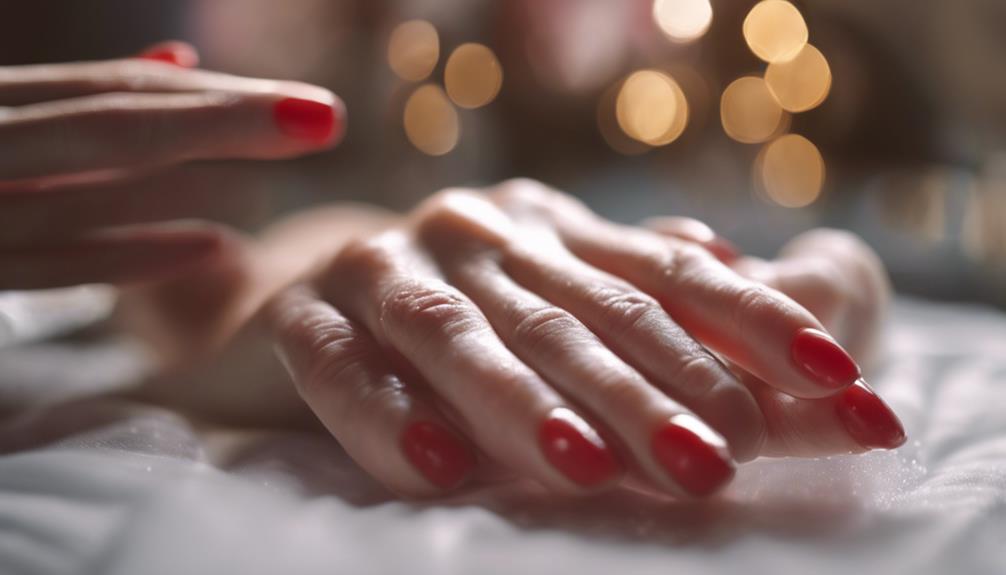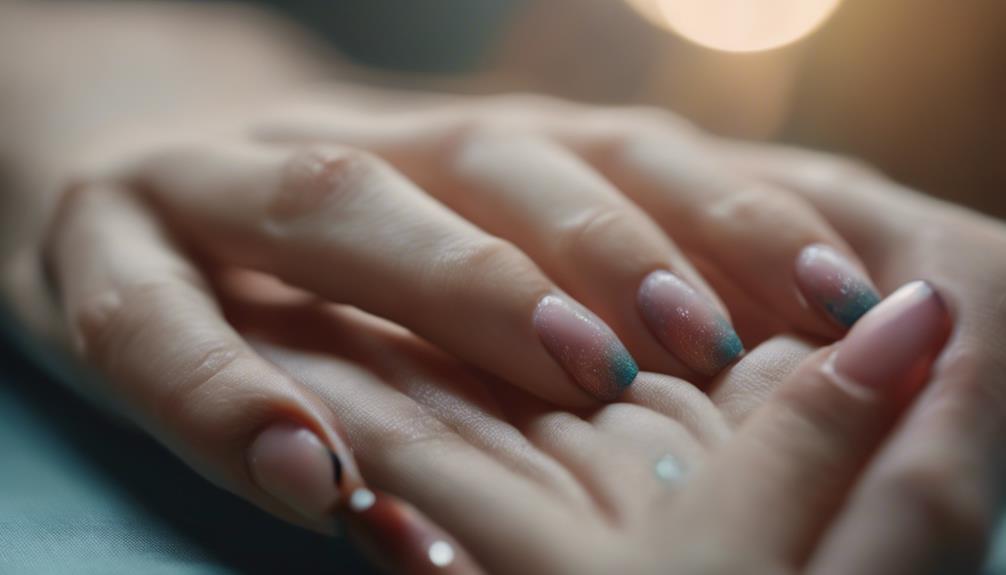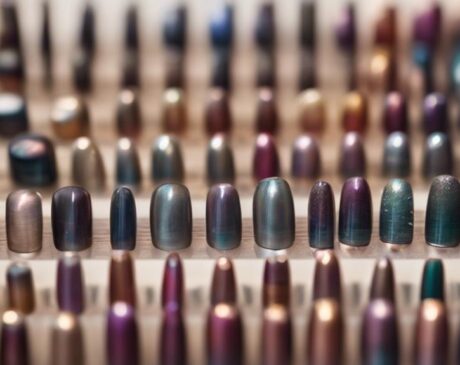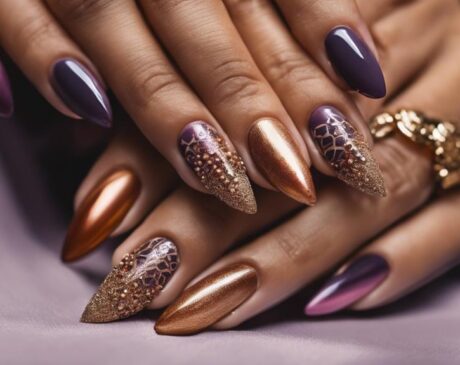Why Do My Fake Nails Hurt When I Press on Them?
If your fake nails hurt when you press on them, it might be because they were applied incorrectly or are too long. Your nail bed could be sensitive or you may be having an allergic reaction. Sometimes underlying nail conditions can cause discomfort. Consider why your nails are causing pain and make changes for relief. There may be more helpful tips to understand and manage your nail discomfort.
Key Takeaways
- Improper nail application can cause pain; ensure correct placement and application techniques for comfort.
- Excessive nail length may lead to discomfort, catching, and soreness, affecting hand use.
- Nail bed trauma from prolonged wear can result in sensitivity; use proper sizing and gentle application.
- Allergic reactions to products can cause pain; choose hypoallergenic options and consult a dermatologist if needed.
- Underlying nail conditions like fungal infections or trauma can increase sensitivity; correct application techniques for relief.
Improper Nail Application
If you rush through applying fake nails, you might experience discomfort due to improper nail application. Take your time and ensure you follow the correct steps to avoid any unnecessary pain.
Start by gently pushing back your cuticles and shaping your natural nails. Next, select the right size of fake nails for each of your natural nails. Apply a thin layer of glue and press the fake nail firmly onto your natural nail, holding it in place for a few seconds to allow it to bond properly.
Avoid placing the fake nails too close to your cuticles or skin to prevent any irritation.
Excessive Nail Length
Having excessively long fake nails can lead to discomfort and various issues with everyday tasks. When your fake nails are too long, they can easily get caught on things, causing pain and potential damage to your natural nails. Simple tasks like typing on a keyboard or buttoning up a shirt can become cumbersome and painful. The added length puts pressure on your nail beds, making them more prone to soreness and sensitivity.
Moreover, excessively long fake nails can affect your ability to use your hands effectively. Gripping objects or performing tasks that require precision can be challenging and uncomfortable. The constant pressure from the long nails pressing against your fingertips can lead to throbbing and aching sensations.
In addition to the physical discomfort, excessively long fake nails may also impact your overall nail health. The weight and length of the fake nails can weaken your natural nails over time, making them more susceptible to breakage and damage. It's essential to keep your fake nails at a reasonable length to ensure comfort and maintain the health of your natural nails.
Nail Bed Trauma
When you wear fake nails for an extended period, your nail bed can become sensitive and painful due to the constant pressure and weight on your natural nails.
This sensitivity can lead to an inflamed nail bed, causing discomfort and potential damage to your nails if not addressed promptly.
Understanding the signs of nail bed trauma is crucial to maintaining healthy and pain-free nails while enjoying the beauty of fake nails.
Nail Bed Sensitivity
Fake nails can cause discomfort and pain due to nail bed sensitivity, commonly referred to as nail bed trauma. When your nail beds are constantly exposed to the weight and pressure of fake nails, they can become sensitive and painful. This sensitivity can be exacerbated when you press on the nails or accidentally bump them against hard surfaces. To understand more about nail bed sensitivity, take a look at the table below:
| Causes | Symptoms | Treatment |
|---|---|---|
| Incorrect nail sizing | Pain or tenderness | Remove fake nails |
| Improper application | Sensitivity to touch | Keep nails clean and trimmed |
| Allergic reactions | Redness or swelling | Moisturize nail beds |
Taking care of your nail beds is essential for reducing sensitivity and discomfort caused by fake nails.
Painful Nail Bed
Experiencing pain in your nail bed can result from trauma caused by factors like incorrect nail sizing or improper application. When your fake nails are too large, they can press against your natural nails, causing discomfort and pain in the nail bed. This pressure can lead to soreness and tenderness, making it painful when you press on them.
Similarly, if the fake nails are applied too tightly or with excessive pressure, they can damage the nail bed underneath. To alleviate this pain, ensure your fake nails are properly sized and applied gently to avoid unnecessary trauma to your nail bed. Taking these precautions can help you enjoy your fake nails without the discomfort of a painful nail bed.
Inflamed Nail Bed
To prevent inflamed nail beds due to trauma, ensure proper sizing and gentle application of fake nails. When fake nails are too tight or applied too roughly, they can cause irritation and inflammation of the nail bed.
If you notice redness, swelling, or pain around the base of your nail, it's crucial to address it promptly. Ignoring inflamed nail beds can lead to infection and more discomfort.
Give your natural nails a breather in between applications of fake nails to allow them to recover. If you frequently experience nail bed inflammation, consider using alternative nail enhancement methods or consulting a professional for advice.
Taking care of your nail beds will help keep them healthy and pain-free.
Allergic Reactions to Products

If you notice redness, itching, or swelling after applying nail products, you may be experiencing an allergic reaction. Your body might be sensitive to certain ingredients commonly found in nail polishes, glues, or acrylics. Chemicals like formaldehyde, toluene, and dibutyl phthalate can trigger allergic responses in some individuals. These reactions can manifest as red, inflamed skin around your nails, itchiness, or even blistering. It's crucial to pay attention to these signs as repeated exposure to allergens can worsen the reaction over time.
To prevent allergic reactions, opt for hypoallergenic nail products or those labeled as '5-free' or '7-free' to avoid common allergens. Conduct patch tests before using new products to check for potential sensitivities. If you suspect an allergic reaction, remove the nail products immediately and consult a dermatologist for further guidance. Your health and comfort come first, so don't hesitate to make changes to your nail care routine to protect your skin.
Underlying Nail Conditions
If your nails hurt after getting fake nails, consider underlying nail conditions like nail bed sensitivity or incorrect application technique. These issues can lead to discomfort and pain when wearing fake nails.
Understanding these factors can help you address the root cause of your nail discomfort.
Nail Bed Sensitivity
Experiencing sensitivity in your nail bed can be indicative of underlying nail conditions that require attention. If you're feeling discomfort when pressing on your fake nails, it's essential to consider the health of your natural nails.
Here are some factors that may contribute to nail bed sensitivity:
- Fungal Infection: Nail bed sensitivity could be a sign of a fungal infection that needs proper treatment.
- Nail Psoriasis: Psoriasis affecting the nails can cause sensitivity and changes in nail texture.
- Ingrown Nails: Ingrown nails can lead to pain and sensitivity in the nail bed area.
- Trauma: Previous trauma or injury to the nail bed can result in increased sensitivity and discomfort.
Incorrect Application Technique
Sensitivity in your nail bed due to incorrect application techniques can exacerbate underlying nail conditions, potentially leading to discomfort when wearing fake nails. When fake nails are applied improperly, they can put pressure on your natural nails, causing pain and discomfort. Here are some common incorrect application techniques that may contribute to your fake nails hurting:
| Incorrect Application Techniques | Description |
|---|---|
| Incorrect nail sizing | Nails are too big/small |
| Using too much glue | Excessive adhesive used |
| Applying nails too close to cuticles | Overlapping with skin |
| Rough nail preparation | Improper filing technique |
| Applying nails at incorrect angles | Uneven pressure distribution |
Checking and correcting these techniques can help alleviate the discomfort you may feel with your fake nails.
Pressure on Nail Tips

Wearing fake nails can lead to discomfort due to the pressure exerted on the tips of your natural nails. When you press on your fake nails, this pressure can transfer to your natural nail underneath, causing pain and discomfort. To alleviate this issue, consider the following:
- Proper Length: Ensure your fake nails aren't too long, as longer nails can put more pressure on the nail tips when you press on them.
- Quality Adhesive: Use a high-quality adhesive to attach the fake nails securely. Loose nails can shift and cause additional pressure on your natural nails.
- Avoid Excessive Force: Be mindful of the pressure you apply on your nails. Avoid pressing down too hard to prevent unnecessary discomfort.
- Regular Maintenance: Schedule regular touch-ups to maintain the integrity of your fake nails. This can help prevent them from loosening and exerting extra pressure on your natural nails.
Infection Risk
To minimize the risk of infection from wearing fake nails, it's crucial to maintain proper hygiene practices. Bacteria and fungi can thrive in the space between your natural nail and the fake nail, especially if moisture gets trapped there.
To keep infections at bay, make sure to regularly clean and dry your nails thoroughly. Avoid keeping your fake nails on for too long without a break, as this can weaken your natural nails and make them more susceptible to infections. If you notice any signs of infection such as redness, swelling, or pus around the nail area, it's essential to remove the fake nails immediately and consult a healthcare professional.
Additionally, be cautious when getting your fake nails done at salons, ensuring that they follow proper sanitization procedures. By staying vigilant and maintaining good nail hygiene, you can enjoy your fake nails without worrying about the risk of infections.
Frequently Asked Questions
Can Fake Nails Cause Long-Term Damage to My Natural Nails?
Fake nails can potentially cause long-term damage to your natural nails if not applied or removed properly. It's crucial to follow correct procedures and give your nails breaks between applications to maintain their health and strength.
How Can I Prevent My Fake Nails From Lifting or Popping off Prematurely?
To prevent fake nails from lifting or popping off early, ensure proper prep by cleaning your nails, removing oils. Use nail glue generously and seal the edges. Avoid exposing nails to excessive water and use gloves for chores.
Are There Any Specific Products or Brands That Are Less Likely to Cause Irritation or Pain?
For less irritation or pain, consider products with gentle formulas. Look for reputable brands known for comfort. Trial and error might be necessary to find what works best for you. Stay informed and experiment.
Can I Still Get Fake Nails if I Have a History of Nail Infections?
If you have a history of nail infections, consult a professional before getting fake nails. They can provide guidance on the best options for you. Your health and safety are top priorities.
Are There Any Home Remedies or Treatments for Relieving Pain and Discomfort From Fake Nails?
If your fake nails are causing discomfort, try soaking them in warm water mixed with a bit of olive oil. Massage the nail beds gently. If pain persists, consider having them professionally removed to prevent further irritation.




